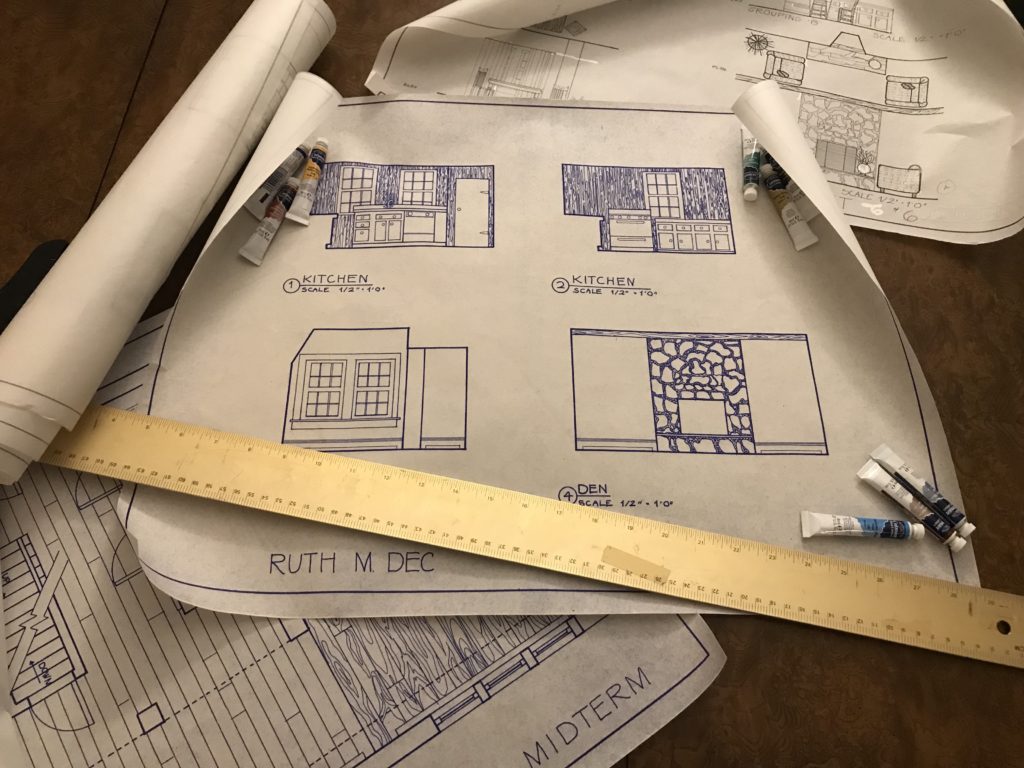
I wonder how often people choose what should be beautiful and what should be ignored. What is the impetus to make things beautiful?
I hated taking the drafting class I needed for interior design. It was the most unforgiving medium I had worked with. If I started a blueprint a sixteenth of an inch off the mark, I had to rip up the drafting paper and start all over again. Working with ink was worse. At least pencil lines could be erased, but the ink just glared at me and taunted me: “You have to start ALL overrrr.”
Still, I was fascinated with observing the other students in the classroom context. Next to me, a young woman effortlessly drafted the most exquisite plan and elevation for a classical style living room. A student behind me was working on the design of a modern office suite. Others worked with the same diligence and ease to create beautiful rooms. I continued to do the best I could despite the constant erasures and drips of ink.

Taking a Break from Ink
When frustrated, I took a break and simply looked around the room, which was downright ugly. Gray walls bereft of posters or decoration, chipped laminated furniture, and glaring fluorescent lights set the tone. Some of the interior design students added to the dinginess by leaving scraps of drafting paper, soda cans and coffee cups around. The walls had a few bits of graffiti. One day the teacher remarked on the paradox that a school and students dedicated to creating beautiful interiors could allow this ugly environment.
Beauty energizes us. If it did not, people would not be willing to spend top dollar for a beautiful interior design.
On the other hand, ugliness depletes us and does so much more. So as the students created the beautiful, soulful interior plans, their environment depleted them. As Thomas Moore said in Care of The Soul, “When the soul is neglected, it doesn’t just go away; it appears symptomatically in obsessions, addictions, violence and loss of meaning.”
Why Do We Allow a Lack of Beauty to Deplete Us
So why do we do this to ourselves…allow the ugly when it depletes us. Part of the problem was that nobody “owned” the room. At least five different teachers and over 300 students used the room from morning until night. Another problem was that the school was a bureaucracy, a New York State college that divided the responsibilities of the room’s upkeep to various departments. Even though the school was an institute geared toward graduating students adept in creating beauty in interior design, fashion, graphic or advertising art, no one seemed to be in charge of the room’s aesthetics.
The Depths of the Problem
I think the problem goes deeper than that, but I do not have an answer. Usually when I am befuddled, I look to our culture’s long history to determine the thinking patterns that have allowed this modern problem.
***
I reflect on The Sacred and the Profane by Mircea Eliade and his description of man’s need to create sacred places to deal with the apparent chaos of the unknown universe. The creation of churches, temples and druid rock formations like Stonehenge brought order and calm to man. The tendency to design such edifices continues in modern humans even if they might not consider themselves religious. They still partake in dividing spaces into the sacred and profane. A garden, gravesite or nostalgic vacation hideaway can serve for the non-religious as the place of the sacred. Still, in humanity’s need to form a sacred place, they have forgotten the other parts. So, I think one reason for the ugliness of the classroom is based on millennia of dividing and forgetting.
***
I think of how Western culture is harmed by the spirit-matter divide. Two thousand years of organized religion in the West tended to make man focus on the spirit rather than the physical. Conversely, the scientific revolution, based on empirical study, pushed the spirit aside to develop a sterilized field to study matter.
***
I think of the belief systems of the indigenous people who have embraced animism. To the animist, all matter is alive and deserves our respect and care, which also includes matter created with our own hands. Intent is paramount to making an article that gives positive energy. The Lakota tribe calls such energy skan. Items made with love have much skan. The chipped furniture was laminated with plastic, a fossil fuel material once termed the devil’s resin because of its impact on our ecology. To me, plastic pulls skan out of the atmosphere. Also, the furniture was probably made in the New York State prisons, for most State and New York City schools buy their furniture from prison shops. The Lakotas say we absorb the feelings of those who create the items we use.
What Should Be Beautiful
So, I think and I think and I think. My gut says there is no escaping the room’s ugliness from everything going on in the world, whether ecological or sociological. We cannot bring beauty to that room unless we deal with the energy associated with these issues. Such a strange connect!
Perhaps we cannot change the design of the room until we address climate change or prison reform.
Today we are being called to change from a divided worldview to one that sees all as one. The survival of the planet demands it as we address our ecological challenges, the effects of prejudice or tribal skirmishes.
Perhaps one way to start embracing a holistic worldview is by bringing beauty into the most mundane areas of life. Beauty, like the sacred, begs us to pull it into our profane world; and once we do, it gives meaning to our ordinary experiences.
And, yes, as I work with ink trying to create the beautiful on paper, I continue to think, to ask and to wonder….
***
Solutions for the Bureaucratic Community- How to Make Things Beautiful
- I think it is the responsibility of the educational facility to teach interior design students a philosophy of aesthetics, especially in conjunction with bureaucracies (un-owned space). The concept probably could not be taught in a course, though many a designer has cried for the need. Perhaps a lecture or a pamphlet would do.
- One way to get interior design students to take ownership of the classroom would be to sponsor a contest in which they would come up with simple means to enliven the space. Because all students using the room would be required to participate, all would begin to become aware of their public environment. The winners could get extra course credit or a notation for their resume. The designs could include a painted graphic for the wall or a poster and some framed prints. Everything would cost the school no more than a few hundred dollars.

Leave a Reply